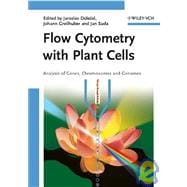
What is included with this book?
Johann Greilhuber is Associate Professor at the Institute of Botany at the University of Vienna. He has studied plant genomes for almost 30 years and is an expert on intraspecific variation of genome size. He has constantly been developing novel techniques to study plant genomes, among them many methods based on flow cytometry.
Jan Suda heads the laboratory of flow and image cytometry at the Czech Academy of Sciences' Institute of Botany. He is a taxonomist specializing in plant biosystematics, including genome size determination and has co-authored a book on taxonomy analysis.
| Preface | |
| List of Contributors | |
| Cytometry and Cytometers: Development and Growth | |
| Overview | |
| Origins | |
| From Absorption to Fluorescence, from Imaging to Flow | |
| The Growth of Multiparameter Flow Cytometry | |
| Bench-tops and Behemoths: Convergent Evolution | |
| Image Cytometry: New Beginnings? | |
| References | |
| Principles of Flow Cytometry | |
| Overview | |
| Introduction | |
| A Brief History of Flow Cytometry | |
| Components of a Flow Cytometer | |
| Flow Cytometric Informatics | |
| Spectral Compensation | |
| Cell Sorting | |
| Calibration Issues | |
| Conclusions | |
| References | |
| Flow Cytometry with Plants: an Overview | |
| Overview | |
| Introduction | |
| Fluorescence is a Fundamental Parameter | |
| Pushing Plants through the Flow Cytometer | |
| Application of Flow Cytometry in Plants | |
| A Flow Cytometer in Every Laboratory? | |
| Conclusions and Future Trends | |
| References | |
| Nuclear DNA Content Measurement | |
| Overview | |
| Introduction | |
| Nuclear DNA Content: Words, Concepts and Symbols | |
| Units for Presenting DNA Amounts and their Conversion Factors | |
| Sample Preparation for Flow Cytometric DNA Measurement | |
| Standardization | |
| Fluorescence Inhibitors and Coatings of Debris | |
| Quality Control and Data Presentation | |
| Future Directions | |
| References | |
| Flow Cytometry and Ploidy: Applications in Plant Systematics, Ecology and Evolutionary Biology | |
| Overview | |
| Introduction | |
| Practical Considerations | |
| Applications in Plant Systematics | |
| Applications in Plant Ecology and Evolutionary Biology | |
| Future Directions | |
| References | |
| Reproduction Mode Screening | |
| Overview | |
| Introduction | |
| Analyses of the Mode of Reproduction | |
| A Recent Innovative Method: the Flow Cytometric Seed Screen | |
| Flow Cytometry with Mature Seeds for other Purposes | |
| Conclusions | |
| References | |
| Genome Size and its Uses: the Impact of Flow Cytometry | |
| Overview | |
| Introduction | |
| Why is Genome Size Important? | |
| What is Known about Genome Size in Plants? | |
| The Extent of Genome Size Variation across Plant Taxa | |
| Understanding the Consequences of Genome Size Variation: Ecological and Evolutionary Implications | |
| Methods of Estimating Genome Size in Plants and the Impact of Flow Cytometry | |
| Recent Developments and the Future of Flow Cytometry in Genome Size Research | |
| References | |
| DNA Base Composition of Plant Genomes | |
| Overview | |
| Introduction | |
| Analysis of Base Composition by Flow Cytometry | |
| Conclusions | |
| References | |
| Detection and Viability Assessment of Plant Pathogenic Microorganisms using Flow Cytometry | |
| Overview | |
| Introduction | |
| Viability Assessment | |
| Immunodetection | |
| Conclusions and Future Prospects | |
| References | |
| Protoplast Analysis using Flow Cytometry and Sorting | |
| Overview | |
| Introduction | |
| Results of Protoplast Analyses using Flow Cytometry and Sorting | |
| Walled P | |
| Table of Contents provided by Publisher. All Rights Reserved. |
The New copy of this book will include any supplemental materials advertised. Please check the title of the book to determine if it should include any access cards, study guides, lab manuals, CDs, etc.
The Used, Rental and eBook copies of this book are not guaranteed to include any supplemental materials. Typically, only the book itself is included. This is true even if the title states it includes any access cards, study guides, lab manuals, CDs, etc.